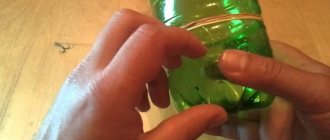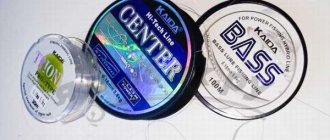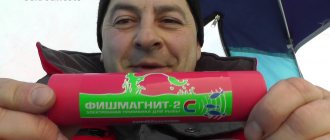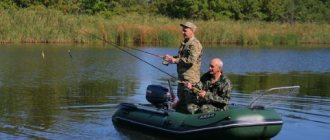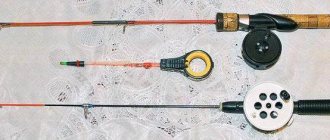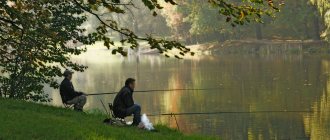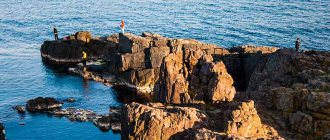Winter carp fishing
For some reason, winter fishing with tops and other traps is almost never practiced (with the exception of katiskis and ice traps, described in detail below), although due to the first ice, crucian carp should enter them in those places where they do not hibernate.
At least when fishing for lake fish in winter with a catfish - no different in principle from the top - crucian carp are not a rarity among the catch. Only at the end of the season, when the oxygen regime in stagnant reservoirs deteriorates, crucian carp quite actively fall into vertically installed peaks, i.e. tied with the neck up to a pole driven into the bottom of the reservoir.
https://www.youtube.com/watch?v=jpFX-Z3TKlw
In this case, baits are not used; the bait is fresh air entering the water from the ice hole.
Fishing from above is most often used in densely populated areas - on city and village ponds, where carp are quite simple-minded and are accustomed to safely eating food floating on the surface, which is thrown in abundance to them or to ducks.
Fishing for carp using bread crust is very simple and effective. The gear used for it is quite primitive and even crude: a spinning rod (long, strong, with a large test load) is equipped with an inertial reel filled with 100 meters of fishing line with a diameter of 0.5–0.6 mm; 3 leashes (25–30 cm long and 0.35 or 0.4 mm thick) with hooks No. 10–12 are tied to the main fishing line.
The leashes are tied to one point so that they fan out. That's all, the tackle is ready - neither a float nor a weight is needed; instead, half a loaf or a loaf of bread is used: its weight allows you to make long casts, and it also serves as bait.
The crust of half the bread is cut off on four sides to increase the area of open bread crumb. Usually, only the bottom crust is left, which is stronger and soaks longer in water; the main line is threaded through it using a large needle three times, then leashes are attached to it, and cubes from the cut crust are put on the hooks, and the size of the nozzle is not small - so that it cannot be swallowed crucian carp or juvenile carp, fishing is designed for trophy specimens.
Rice. 49. Planting a crust for carp fishing on top.
How to make a face? Progress
Making a device at home is not difficult if you follow the following sequence of actions:
- The first step is to make a hoop. It’s good if you managed to find a ready-made wood product. Otherwise, the home craftsman will have to make it himself. For this purpose, hard wire, previously sanded with sandpaper, is suitable. To prevent the product from rusting, a special antiseptic is applied to its surface. After the substance has dried, the hoop is given the required shape and size. Tree roots and branches are also suitable as material. The consumable material will be more elastic if it is first dipped in boiling water. Otherwise, working with wood will be difficult. Next, both ends of the hoop are pulled together and secured with a strong thread.
- Make the body of the muzzle. The rods are collected into a bundle and aligned in length. One tip is separated from the bunch, it needs to be tied to a hoop, and a stick placed under the string. Do the same with the rest of the rods. In order not to confuse the rods intended for making the body with the material for the cone, every second rod should be separated. The hoop is tied around the circle with it. The rods that will be used in the body are attached and fixed with a transverse braid to another hoop.
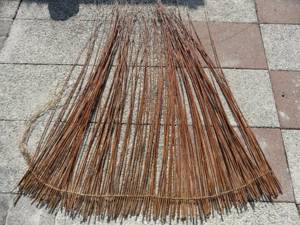
- To increase the length of the body, new branches are added to its rods and braided to a new hoop.
- After weaving, they begin to make holes in the trap cone. For this purpose, the craftsmen, stepping back a little from the braid, cut off all excess from the rods.
- So that the caught fish can be removed from the trap, a special hole is made in the structure. It is done in those rods that are located between different hoops. The dimensions of the windows may vary. It all depends on the size of the fish caught. They are closed using special doors that are woven separately. They are attached to the structure itself using a rope.

Judging by numerous reviews, the procedure for making a muzzle for catching fish is quite labor-intensive, but simple, and even a novice fisherman can handle it.
Crucian carp stewed in sour cream with potatoes and onions
The most optimal size of fish for frying is the size of the palm of an adult man, i.e. weighing 250-300 g. Larger specimens do not spoil the taste of the dish, but eating turns from pleasure into a boring struggle with small bones.
Cleaned, gutted and washed crucian carp of the specified size are not cut into pieces, but fried whole. Before frying, they are sprinkled with salt and pepper, rolled in flour, and fried in vegetable or melted butter.
When one side is browned, turn the fish over, pour sour cream on it and finish frying. If the fish has a “herbal” smell, then the cleaned carcasses should be salted, lightly rubbed with vinegar (the main thing is not to overdo it) and left for an hour in a cool place.
Product consumption: 1.5 kilograms of crucian carp, 70 grams of flour, 80 grams of butter, 1 kilogram of sour cream.
This method is also suitable for larger (up to a kilogram) fish. Peel the crucian carp, gut it, rinse well in running water, and if necessary, cut into portions.
Boil the potatoes; fry onions, cut into rings, in melted butter. Roll the crucian carp in flour and brown on both sides in a frying pan.
Place fried onions on the bottom of the baking sheet, on top of it - fried fish and boiled potatoes cut into slices. Add salt, pour sour cream, sprinkle with ground breadcrumbs and place in the preheated oven for 20-25 minutes.
In the oven, the crucian carp “languish” and their small bones soften.
And here's what you need to know: Fishing with a quok from a stationary boat
Fishing top
When there was no modern gear yet, our ancestors used improvised means to make all kinds of devices to catch fish. This is the top. One of these inventions has survived to this day almost unchanged. Modern technology has made changes and improved this gear, but at the same time narrowed its specificity. The top was woven from branches and vines. It consisted of 3 parts: the main part resembles a cylinder, the other two parts are made removable - the bottom and the throat.
The throat is a removable part of the top; it looks like a cone with a cut off top. The top was used in two ways: under water and for catching with hands in a standing cylinder.
In small channels between lakes, in swamps, in shallow pools, in places with standing water and a muddy bottom, where the fish are lazy and like to rummage in the mud, it is not so easy to fish with a fishing rod. But the top, or rather the cylinder from it, is just right. A cylinder made of twigs and vines, about a meter in diameter, was carefully lowered into the water and sharply placed just before the bottom. The trapped fish were pulled out by hand. The top is rearranged several times.
For underwater fishing, the top was completely assembled: the bottom was attached to the cylinder and the neck was put on. Bait (porridge, peas, pieces of fish and intestines) was placed inside. It turned out to be a trap - having sensed the bait, the fish enters the top through the throat, but cannot get back out.
Modern tops are made from high-quality materials: metal-plastic frames covered with metal or nylon mesh. The frame is rigidly fastened with longitudinal ribs, so it can be immediately thrown from the shore or lowered from the boat. But such tops are bulky and are increasingly used as a spring version. There are no ribs in it, but there are several turns of a large spring covered with mesh. For transportation, simply fold the spring and secure it with latches. For convenience, the gear has additional improvements: a zipper to make it easier to get the catch, sewn-in net bags for bait.
If you are relaxing by a pond and want to enjoy fish soup from minnows and other small fish, then you can easily make an impromptu fish soup from an ordinary plastic bottle. You need to cut off the neck, put some bread and bury the bottle in the water. A curious fish will definitely end up in the bottle, and you are guaranteed a rich fish soup.
Do not forget the experience of our ancestors, use it, this gift is priceless.
sudak-fishka.ru
Donks, “makushatnitsy”, “springs”
The classic of our fishing literature L.P.
Sabaneev denied the possibility of catching large carp on donkeys: “As a matter of fact, there is only one method (of fishing for carp - A. Sh.) - fishing with a long rod with a float.”
Sabaneev explained the unsuitability of donks by the fact that when fishing with donkeys, not being able to absorb the jerks of the fish with a long flexible rod, “for large specimens it is necessary to make fishing lines of several dozen hairs, but this cautious fish does not take very thick fishing lines.”
By the 50-60s of the 20th century, the situation had changed: with the advent of durable and fairly thin nylon monofilament fishing lines, carp fishing enthusiasts increasingly began to take for fishing not a bunch of bulky fishing rods, but several much more compact hooks. Catching carp with donks at stakes (ponds) in the southern regions has become especially widespread: in Ukraine, Kuban, and Moldova.
By the way, it was then that paid fishing for pond carp began - collective and state farms, for little money, allowed amateurs to fish on those of their ponds where semi-cultured fishing was carried out.
How to properly place a top on a crucian carp
Crucian carp on top
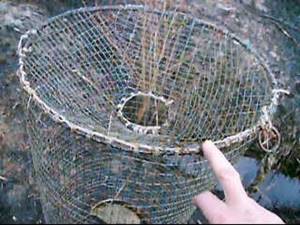
(Shaganov Anton). Rice. 13. Triangular and semi-cylindrical tops on wooden frames.
Thus, the best pond for catching crucian carp with tops is one populated with pure gold crucian carp, and the pond is not small in size. Golden crucian carp is very tenacious. The top can be placed anywhere in the pond. Attracted by the smell of crucian carp, sooner or later, he will come to this place. Thus, the best pond for catching crucian carp with tops is one inhabited exclusively by golden crucian carp, and not of small size.
Fishing tactics. Fishing for crucian carp with a top is the simplest, and there are almost no misfires, even if the top is placed away from the usual feeding areas of crucian carp. It is better to start fishing for crucian carp in early spring, in sufficiently warmed reservoirs, where the bottom is muddy and soft.
I would like to note that catching crucian carp on the top of the video However, fish such as pike, crucian carp, carp spawn in the shallows and give away the spawning site with noisy splashes, signaling: the top placed here will not be left without a catch.
However, fish such as pike, crucian carp, and carp spawn in the shallows and give away the spawning site with noisy splashes, signaling that a fish placed here will not be left without a catch.
Venter (five, yater, secret). Linguistic scientists believe that the Russian names and To catch more crucian carp with tops, you should follow the following simple rules. Fishing tactics. Catching crucian carp with a top is the simplest, and there are almost no misfires, even if the top is placed away from the usual feeding areas of crucian carp.
Bait for catching carp in stagnant “wild” waters is mandatory; without it, you can only count on an accidental catch. However, in fish ponds where paid fishing is organized and where the fish are regularly fed, you can do without feeding, or limit yourself to those small portions of aromatic bait that are attached directly to the bottom tackle.
But we must take into account that the main and most common food of carp in the mentioned ponds is granulated feed, and other baits and baits will be ineffective.
Fishing with muzzles and lines
Fishing with muzzles and other frameless traps woven from rods or made of a rigid metal net is no different from fishing with tops. Wicker traps catch smaller crucian carp, as well as loaches and loaches if they are found in the pond.
Verkhovka and pond gudgeon also do not shy away from such muzzles. In lakes rich in crucian carp, they are successfully caught using traps with wings (merezhs and venters), mainly in the spring and without bait.
Sometimes they stretch the lines in the summer, often by removing the wings, but always with bait - but such fishing is less convenient, since it requires a boat or the need to get into the water for each check of the gear.
If the fisherman is faced with the task of catching not large crucian carp, but small things for live bait, he can successfully use any, the most primitive traps, often made from scrap materials. For example, some fishermen very quickly turn small mesh cages into tops by attaching 3-4 pieces of wire or simply twigs cut from a bush as ribs (in the latter case, the improvised top needs to be additionally loaded).
By making a sufficient number of holes in a leaky iron bucket and closing the entrance with a neck made of fine mesh or even a rag, you can also catch good baitfish.
Fishing for tench is exciting, since not everyone manages to catch tench; this fish leads a hidden lifestyle, sticks to certain areas of the bottom, eats pickily and is rarely hooked. But a fisherman who has studied the reservoir well and knows the habits of the tench will always be able to catch the tench; It is important to get into the right weather, be observant and experiment with baits and bait.
The easiest way to catch tench is during its active biting period. The beginning of summer feeding activity of tench is largely associated with its spawning, which occurs at a temperature of 20 C.
This water temperature in the reservoirs of central Russia usually occurs in late May–early June. Therefore, taking into account the fact that the fish get sick for some time after spawning, and then begin to actively replenish lost calories, the peak of tench biting occurs at the beginning or middle of summer.
The difficulty in choosing a place to catch tench is due to the fact that tench do not gather in large schools. In spring, tench form pairs, and after spawning, large tench prefer to stay alone. Sometimes you can find areas where small tench bite quite often, apparently they are attracted here by food.
Where is the best place to catch tench? As a rule, in rivers, lakes and ponds, this fish chooses muddy backwaters, creeks, and bays with a lot of algae for its habitat. In reservoirs with low-flow water, such places can be very far from the shore, so here you have to fish from a boat, throwing a float rig under the edge of the algae.
Tench likes to stay above a hard bottom with a small layer of silt. On such soil you can find thickets of horsetail, and it is here that tench most often wander in search of food. Sometimes you can see how the stems of the horsetail sway as the fish moves. It is better to catch tench in such places.
Large, rough floats, used by some even experienced tench anglers, are inconvenient because they present significant resistance and the fish are more likely to be impaled. To what depth to launch the float depends on the bait and the properties of the bottom, but, in any case, with lines, with the mentioned exception, fishing with snails is certainly from the bottom.
Only some advise launching the float so that the nozzle lightly touches the bottom, others - so that the nozzle lies on the bottom and the sinker almost touches it; Still others, finally, consider it more correct for the sinker to be at the bottom.
Most often you have to catch using the first method, less often - the last. In this case, you have to resort to the sliding float already described, see Fig.
But since the success of fishing depends a lot on the correct placement of the float, and it is impossible to measure the depth here, it is best to use sliding floats, which at the same time show the depth.
- Fishing on Akhtuba with children
- Biting forecast in Kirovograd for two weeks
- Videos fisherman
- Fishing for roach in Kamyzyak
- The classic one is used when catching any type of fish.
- Specialized is used for a specific type.
This invention of the famous Moscow fisherman N. Pavlovsky is especially suitable for long-distance casting.
The latter should be painted with oil paint and covered with oil varnish. The drawing depicts the float in the form it takes when thrown into the water. Once in the water, the load goes to the bottom, a large float remains on the surface and serves to indicate the bite; The purpose of the small float is to support the nozzle so that it does not sink to the bottom and prevent the load from being sucked into the mud.
Two hooks are more convenient because the bottom one often gets caught in grass or moss and the fish may not notice the bait. A well-calibrated float always shows the subtlest bite.
You can fish with it on long rods with or without a reel, as well as short ones, but certainly with a reel. The line should be silk, more or less thin, well-tarred and a length from 15 for long rods to 25 or more for short ones.
The bite of tench is very original and differs sharply from the bite of other fish. With rare exceptions, it is expressed as follows: The fact is that the tench first tries, sucking the bait with its small, as if swollen mouth, throwing it several times.
When the bite is bad, the matter is limited to this sucking, so that the worm, for example, more often its tip, is squeezed out and crushed. But if the tench is not very full, then sooner or later he will take the entire bait into his mouth and then move on on his way.
He puts the float only when the sinker lies at the bottom or almost reaches it. In rare cases b.
There is always time to prepare for hooking. You need to hook as soon as the float moves to the side, without waiting for it to disappear under water.
At this moment, the tench often pricks and spits out the bait, much less often swallowing it. Inexperienced anglers usually hook too early, when the line is moving the float from one side to the other.
You need to hook in the direction opposite to the direction of the float, and when fishing without a reel, it’s quite sharp. The tench's lips are healthy, and it breaks off quite rarely; therefore, if the tackle is reliable enough, there is no need to stand on ceremony with it and it is more prudent to immediately drag it to the boat and catch it with a net.
For large tench, over 5 pounds, it doesn’t hurt to lightly move in small circles, having previously grabbed or moved other fishing rods so that they don’t get mixed up. Tench walks very slowly on a fishing rod, weaker than a perch of the same size, but quite stubborn; a large one often becomes perpendicular to the bottom, resting its head, sometimes it is difficult to remove it from this position.
If the hook is stuck into the pubic part and was caused by a break-in, then it can be broken. It is no less annoying when the line rushes into the grass and gets tangled there, twisting the line behind the grass.
The tench fish prefers to take food from the bottom of the reservoir near the coastline. That is why float tackle is ideal for catching it.
Simple installation of equipment is used, but you should still approach the choice of materials responsibly, since otherwise the trophy will go away along with the hook. The first step is to select a fishing rod.
It can be of any type, so every angler planning to catch tench can use almost any form. It is still recommended to use long rods up to 6 m.
Tench fishing: tackle, bait, groundbait, tench fishing tactics
They will allow you to fish the coastal zone in the best possible way. The angler will have the opportunity to ensure accurate casting into the windows between aquatic plants.
M rods are usually used because they provide the best balance of length and weight. You can use fly, Bolognese and plug rods.
The number of bites does not depend on this choice. The main thing is that the form is reliable and can withstand the jerks of a large line.
Installation is done in the most primitive way without swivels and beads. First, a leader material about 40 cm long is taken and a hook is tied to it.
In the spring in the north-west of Russia - at the end of April or beginning of May, depending on the terrain and weather, hungry silver crucian carp, just emerging from hibernation, wander in dense flocks around the reservoir in search of food.
If such a flock approaches the top, then in just half an hour 30-40 weighty crucian carp can crowd into it.
Then the school moves away, and the top again stands for hours without a single fish. Catching crucian carp with muzzles and other frameless traps woven from rods or made of a rigid metal net is no different from fishing with tops.
Wicker traps catch smaller crucian carp, as well as loaches and loaches if they are found in the pond. Verkhovka and pond gudgeon also do not shy away from such muzzles.
In lakes rich in crucian carp, they are successfully caught using traps with wings, merezhs and vents, mainly in the spring and without bait. Sometimes they stretch the lines in the summer, often by removing the wings, but always with bait - but such fishing is less convenient, since it requires a boat or the need to get into the water for each check of the gear.
If the fisherman is faced with the task of catching not large crucian carp, but small things for live bait, he can successfully use any, the most primitive traps, often made from scrap materials. For example, some fishermen very quickly turn small mesh cages into tops by attaching 3-4 pieces of wire as ribs or simply rods cut from a bush; in the latter case, it is necessary to additionally load the improvised top.
By making a sufficient number of holes in a leaky iron bucket and closing the entrance with a neck made of fine mesh or even a rag, you can also catch good baitfish. In late spring or early summer, if the spawning of carp is delayed, you can catch their meres with wings.
This fishing is similar to the net fishing that occurs at the same time, but the mesh and its wings are stretched not on the approaches to the spawning grounds, but in the thickets themselves. This is not to say that fishing is very rewarding - you come across not the largest carp, weighing 1-2 kilograms, and in quantities that do not boggle the imagination.
Let me make a reservation that we are not talking about the lower reaches of South Russian rivers during the period of the mass movement of carp - there the meres and venteri at this time are literally bursting from the fish packed into them; but in this chapter there is a story about fishing for pond and lake carp in the middle zone.
In the summer, after spawning, carp are reluctant to go to ordinary tops with bait inside, intended for catching crucian carp, even if they are found in the same pond and if the size of the neck of the tackle allows a large fish to squeeze into it.
Often you come across only small, palm-sized carps.
Crucian carp on top
(Shaganov Anton). Rice. 13. Triangular and semi-cylindrical tops on wooden frames.
Thus, the best pond for catching crucian carp with tops is one populated with pure gold crucian carp, and the pond is not small in size. Golden crucian carp is very tenacious. The top can be placed anywhere in the pond. Attracted by the smell of crucian carp, sooner or later, he will come to this place. Thus, the best pond for catching crucian carp with tops is one inhabited exclusively by golden crucian carp, and not of small size.
Fishing tactics. Fishing for crucian carp with a top is the simplest, and there are almost no misfires, even if the top is placed away from the usual feeding areas of crucian carp. It is better to start fishing for crucian carp in early spring, in sufficiently warmed reservoirs, where the bottom is muddy and soft.
I would like to note that catching crucian carp on the top of the video However, fish such as pike, crucian carp, carp spawn in the shallows and give away the spawning site with noisy splashes, signaling: the top placed here will not be left without a catch.
However, fish such as pike, crucian carp, and carp spawn in the shallows and give away the spawning site with noisy splashes, signaling that a fish placed here will not be left without a catch.
Venter (five, yater, secret). Linguistic scientists believe that the Russian names and To catch more crucian carp with tops, you should follow the following simple rules. Fishing tactics. Catching crucian carp with a top is the simplest, and there are almost no misfires, even if the top is placed away from the usual feeding areas of crucian carp.
Universal traps that can be used in any body of water for different types of fish. Equally effective for use in rivers with strong currents or lakes, in areas unsuitable for nets or in deep waters.
There are other names for the device, such as wick, venter or versha. For many centuries, our ancestors successfully used such a homemade device in stormy waters, in small creeks and in small shallow lakes.
This type of fishing remains popular among fishing enthusiasts of all ages to this day.
Two types of trap:
These devices differ in size, body shape, neck design and material of manufacture. They also vary in price in stores.
Externally, the muzzle looks like a cylindrical pipe inside of which entrances in the form of a neck are inserted. The inlet neck is round, conical at the end. For greater convenience, guide wings are attached to the device.
The muzzle, which is used for a certain type of prey, is made in a square, triangular or semicircular shape. The size of the trap should correspond to the volume of the desired catch. The wings on the muzzle do not exceed 2 m in length; their size depends on the depth of the intended fishing site.
By correctly combining the type of design, size, length of the wings and the nature of the reservoir, you can count on a successful catch.
Device specifics
The classic design, properly installed, gives its owners an excellent catch. The device is small but effective for medium-sized mining. The prey is easily removed from the trap and the muzzle is again ready for use. Regardless of the water temperature and weather conditions, fishing on the top has a positive result.
Despite the fact that such traps are available for free sale in many specialized stores, opinions about it differ radically. Some believe that the use of large device sizes affects the population of species; this is especially true in our country, where poaching is rampant. There is a ban on the use of muzzles for industrial purposes without permission from the relevant authorities.
Others have a positive attitude towards this type of fishing if the trap is intended for small catches. This device has been used since ancient times and it did not affect the population. It is amateur fishing with the help of a muzzle that does not bring harm, unlike poaching.
The muzzle is popular for its versatility and durability, so it is often made independently using natural materials.
How to make from wire
Having prepared the necessary materials, you can create the device yourself in several stages.
In order for the catch to come out rich, the trap must be installed correctly. To do this, you should know a few rules.
1. The main condition is knowledge of the presence of fish in the desired area of the reservoir. More often the muzzle is placed in shallow water, but this is not a hard and fast rule. Thanks to its versatility, it also performs well in deep waters.
2. To hold it, the trap is weighed down with weights. Their number depends on the depth of the intended installation. The main thing is to know exactly the direction of the current. For insurance, the muzzle can be tied to the nearest tree or bush. The firmly fixed structure will not float away even in strong currents.
3. For a good catch in a river with a strong current, it is recommended to install wings on the muzzle so that the prey does not escape. In still water, wings are not required, it all depends on desire.
Distributed among amateurs and professionals. It is considered a universal device for fishing in any body of water, regardless of the depth or strength of the current. Despite all its advantages, the trap is illegal, so it must be used with caution.
There is no special bait for the device; anything that is used when using the rod is suitable. You can make a trap yourself from natural materials without spending money. The product is sold in specialized stores of various shapes and sizes. The materials used for them are completely different, which does not interfere with its effectiveness.
The device is simple and does not require special knowledge during operation, so it is suitable even for a beginner or amateur. The main rule when fishing is to know the specifics of the reservoir and the direction of movement of the prey.
Crucian carp with mushrooms, baked in foil
As has already been said, crucian carp are absolutely not suitable for fish soup, and if you really want to taste them right on the shore of a reservoir, it is best to bake the fish over a fire. Fish (of the same size as for frying) are not scaled, only gutted and washed.
And here's what you need to know: Riding tackle for grayling - manufacturing
Place each individually on pieces of food foil (you don’t have to grease the foil with oil, crucian carp is quite a fatty fish). If you have carcasses, you can put finely chopped green onions, parsley leaves and other herbs inside.
Season with salt and pepper and carefully wrap in foil so that the juice does not leak out during baking. Rake up the coals of the burnt fire, place the bags of fish in the ash, cover the top with hot coals and bake for 10-15 minutes.
Serve directly in foil, with baked potatoes in the same place, use with Russian vodka in moderate quantities. Product consumption: crucian carp - according to the catch, potatoes - according to availability, salt, spices - to taste, vodka - no more than 100 ml per baked fish.
If you bake crucian carp not on the shore, but at home, you can make the taste of the previous dish much more refined. Peel the mushrooms (preferably champignons or porcini), rinse well in running water and leave to drain.
Finely chop the onion and fry in hot fat until golden brown. Place the mushrooms cut into strips on the fried onion, add salt and simmer lightly without covering with a lid.
Crucian carp (unlike field conditions) must be scaled, gutted, washed and salted. Place each fish on a separate, fairly large piece of household aluminum foil, greased.
Place stewed mushrooms on top of the fish, carefully wrap in foil and place on a baking sheet. Bake in a well-heated oven for at least 15 minutes.
Sprinkle baked crucian carp with lemon juice and serve with young boiled potatoes sprinkled with herbs.
From straight branches of bushes and plants growing near a pond, you can make the simplest tops. First, a frame is assembled from the prepared branches, consisting of 5 - 10 circles and 3 - 4 longitudinal poles. Circles are tied to poles using wire, fishing line, strips of fabric, bast. The resulting frame is intertwined with thinner branches in such a way that the distance between them, depending on the size of the fish, does not exceed 1-3 cm. The entrance to the top is made in the form of a funnel with a narrow opening-neck. The result is a kind of trap, repeating the shape of a sippy inkwell. The bait is suspended inside the top on small leashes. The top is checked several times a day, the caught fish is pulled out through the untied blind end (Fig. 1) .
There are several ways to make a funnel entrance to the top. Flexible branches of the longitudinal braid can be bent inward (Fig. 2) , heated over a fire and tied to the entrance ring. Fragile branches that cannot be bent can be broken, but so that they are held at least on the bark, bent and again tied to the ring that forms the entrance (Fig. 3) . Finally, you can use thin poles with side branches equally cut off in the butt part, which, converging in the center, form a funnel (Fig. 4) .
In the case when, when constructing a top, it is not possible to connect the rings that form its frame, you can make a simplified version of the top of an unconventional triangular or oval shape. To do this, you need to find and cut several poles (slingshots) of the same thickness and type, forked at the end. Then connect the diverging ends of the “slingshots” and tie longitudinal poles to the resulting elements of the transverse frame, which are then intertwined with thin branches (Fig. 5) .
There is another top design made from the trunk of a hollow tree.
Having found such a hollow trunk, you need to saw off a 1-2-meter log from it. The result is a hollow cylinder. One side of it must be braided with branches or covered with a piece of polyethylene or fabric. On the other side, at an angle of 30 - 60°, drill or burn through holes into which to drive strong branches until the required size of the funnel is formed (Fig. 6) .
Fry can be caught with improvised nets made from parts of clothing or pieces of fabric. You can make a kind of funnel top from a 2-3 liter glass jar. To do this, you need to roll up a bag from a piece of leather, thick polyethylene, or birch bark, leaving a small hole in its lower part, insert it into the neck of the jar and secure it.
The jar with the bait placed inside is placed on the river bottom with its bottom against the current and tied to a peg driven into the ground. The fish that notices the bait swims inside and finds itself in a trap (Fig. 7) . When catching small fish, you can do without a funnel by stretching polyethylene or a piece of leather with a small hole in the middle over the neck of the jar and securing it at the edges with an elastic band or rope. It’s even more convenient to put a nylon lid on the jar and cut a hole in it. Such a flat “funnel” is also capable of holding fish caught inside.
Using the same principle, a top is made from a plastic bottle. To do this, its neck is cut off, which, upside down, is tightly stuck into the remaining “glass” and secured with wire, thread or thickly smeared resin (Fig.

Minnows can be caught using bowls or flat, 3-7 cm high, salted herring jars. The top of the bowl is covered with a cloth in which a hole the size of a walnut is cut. In this case, the hole should be located in the middle of the bowl. The ends of the fabric are secured to the edge of the bowl.
A piece of bread or other bait is thrown inside. The tackle is taken out to the riffle of the river and buried in the ground so that its top is at the bottom level. In just half an hour, up to two dozen minnows can be crammed into a bowl. You can catch minnows in much the same way using a bucket (Fig. 9) .
In addition to the described tops and traps, ancient fishermen successfully used primitive gill nets woven from thin strips of bast taken from tree trunks. Gilled - because the fish, when caught in the net, became entangled in their gills. Clay balls or stones tied to the bottom of the net were used as sinkers. The net was installed across the current or along aquatic vegetation in places where fish accumulated.
I’m not sure that modern “Robinsons” are capable of weaving a net from bast, but from more modern materials - why not? You just need to have plenty of rope and patience. The required amount of rope can be obtained by unraveling a nylon rope, a towing end, or, using climbers' terminology, the main rope into separate threads.
Thick nylon ropes are almost always woven from many individual strands, quite suitable for weaving nets. Methods of weaving nets are shown in Fig. 10, 11 . The mesh size for nets is usually selected depending on what kind of fish the fisherman intends to catch. Most often it does not exceed 2-5 cm.
Fishing with nets has its own characteristics, which are best learned about in advance, and preferably not theoretically. On large bodies of water, the net is easiest to use as a drag net. To do this, it is necessary to go deeper into the water and stretch the net, move along the shore, gradually approaching it and bringing the ends of the tackle forward.
Moreover, the higher the speed of the fishermen at the last stage of fishing - pulling the net ashore - and the more noise they make, driving the fish trying to escape back into the trap, the greater the catch promises to be.
Narrow rivers and streams can be blocked with nets across the current, from bank to bank. In the water, the net is straightened with the help of stones, sinkers tied to its lower edge, and floats made from tree bark, bunches of reeds, etc.; improvised material. To make the net less likely to cling to debris floating along the river, it should be installed at an angle to the flow (Fig. 12) . It is also possible to straighten the net using two transverse poles (Fig. 12) .
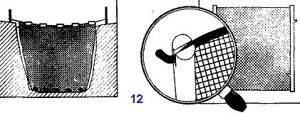
(sometimes called wooden nets, snacks, etc.)
promise the greatest catch to those in distress In rivers rich in fish, the daily catch of one trap can reach several centners. However, building a trap is quite a long and tedious task and is justified only with passive survival, with the victims staying in one place for a long time, when, once you set the trap, you can harvest the fish “harvest” every day. Typically, traps are built on shallow, narrow rivers and streams that can be blocked across the current, from bank to bank. The design and appearance of traps vary. But the principle of operation of all primitive fishing nets is the same - to block the path of the fish and direct it into a special pen, from which it will be difficult for it to find a way out. That is, the same top, but enlarged to gigantic proportions.
The most similar to their rope counterpart are primitive nets woven from thin strips of bast. They are made on the shore, and then stretched between vertical stakes driven into the ground across the water flow. Moreover, the smaller the spans of the network, the easier it will be to weave them.
Just don’t confuse these bast nets, whose task is only to block the fish’s path, with fishing nets, in which the fish must get tangled and stuck. These are completely different gear with different purposes. Small, weak-flowing rivers can be blocked with a simplified network model consisting of only vertical stripes.
To do this, thin strips of bast are tied at equal distances at the ends to two straight poles. One pole, weighted with stones, is placed on the river bottom, the other is raised above the water on vertical stakes ending in forks. Thus, the water flow is cut by frequent vertical stripes through which the fish cannot pass (Fig. 13) .
In another case, you can do without bast, the preparation of which requires a certain skill, but you will have to prepare a considerable number of straight stakes. The stakes are sharpened on one side and driven close to each other into the bottom of the river, from one bank to the other. It turns out to be a kind of stockade fence, blocking the fish’s path downstream.
The distance between the stakes is chosen depending on what kind of fish the fisherman expects to catch, but usually does not exceed 1-2 cm. It is enough to leave wider holes in two or three places - and almost all the fish will go downstream through them. For greater reliability, especially if curved workpieces are used for construction, vertical stakes can be intertwined with transverse branches, ropes or strips of bast until a classic network shape is obtained (Fig. 14) .
In addition, the nets can take the form of “wicker nets” lowered into the water, where long straight poles are attached to two or three vertical posts. In order for such a net to stand vertically and not be carried away by the flow, it must be attached to stakes previously driven into the bottom (Fig. 14) .
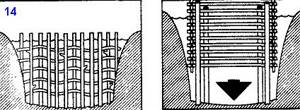
All of these described bast and pole nets are only a design element of the trap , designed to stop and direct the fish to its catching part.
The catching part (pen, cage, pocket, top, etc.) is actually the essence of primitive nets. In the center of the net built in one way or another, a narrow passage is left, below which, behind a trap made of the same nets or stakes spread out on poles, a small cage-pen of a triangular, square or any other shape is built. The entrance has the shape of a funnel, deepened about a third into the cage.
A large fish caught in a trap cannot find its way back, accumulating in dead-end pockets, and the fisherman can only catch it with a spear or catch it with his hands (Fig. 15) . Sometimes the entrance to the pen is made in the form of a gradually narrowing spiral. The fish moves along the fence, gets into the spiral, and along it into the cage (Fig. 15) .
In some cases, to facilitate construction, you can try to narrow the flow by building small dams of stone and pebbles near the banks. Accordingly, the longer the dams are, the less bast and stakes will be needed for the construction of a wooden network.
In rivers with a calm flow, you can try to get by only with a dam made of stones or logs, secured with stakes driven into the ground, and a catch cage built in the gap between two dam sections close to each other. In the absence of a significant number of stakes, the trap can be made of stone.
The stone trap is a strong, high dam that blocks the flow from bank to bank. We must strive to ensure that the water level in the resulting dam rises 1 - 1.5 m above the surface of the river. In the upper part of the dam, three or four passages-troughs are left through which the water will drain down.
Behind the dam, directly under the falling streams, stakes are driven into the bottom to form cages. The fish that falls into the fish tank along with the water becomes the catch of the fisherman. At least the fish that cannot rise against the flow of water falling from a height (Fig. 16) .
For greater guarantee, under the stream of falling water you can place a top woven from branches and placed vertically, like a funnel towards the stream. Thus, the fish immediately falls into the trap with a stream of water.
A simplified version of the top-cage can be built from stakes driven into the bottom next to each other with a 20-30-centimeter branch extending to the side. Branches close to each other and directed inside the paddock form a funnel (Fig. 17) . In wide rivers, where it is difficult to block the entire flow, you can build traps near one of the banks. And in order for the fish to go in the right direction, stand in the middle of a free stream and create noise in every possible way (Fig. 18) .
Another very effective method of “net fishing” is to direct the fish into separate branches of the river, which are then drained. To do this, you need to find a place where the channel is divided into two or more branches, choose the shallowest one, and block the river itself using any of the methods described above.
And if this is not possible, simply drive the fish floating with the current into the preferred branch, making as much noise as possible in the main stream. Accordingly, in the place where the branch connects to the river, it is necessary to install another primitive network. A fish that falls into the sleeve will swim with the flow until the net that blocks its path.
When there are quite a lot of fish in the natural cage, the entrance to the sleeve can be covered with stones and earth. The water will stop rising, the sleeve will quickly dry up - and the fish can be collected from the exposed bottom (Fig. 19) .
The same principle can be used on rivers with a single channel. To do this, part of the stream must be blocked with a primitive net and the fish must be directed inside a long arm-cage arranged parallel to the shore.
In the dead-end part of the cage, you need to dig a pen-trap in the form of a deep hole, connected to the river by a narrow long channel. When the fish gets into the cage, it must be driven into the trap, making as much noise as possible, and the exit from it must be closed (Fig. 20) .
In stagnant bodies of water, traps are made in the form of labyrinths, consisting of many semicircles and spirals connected to each other. The role of the entrance is performed by two semicircles located close to each other, forming a narrow figured corridor. Such a trap is also constructed from stakes driven into the bottom, connected to each other with wire, rope or any other available material for strength.
Finally, you can fish without any gear at all, as they say, with your bare hands . For example, in the puddles left after river floods. The fish cannot leave these reservoirs, which are not connected to the river, and as they dry out, they become increasingly concentrated in a limited area.
Sometimes it is enough to raise dirt from the bottom of these small bodies of water so that the fish, in search of clean water, floats to its surface, where it can be hit with a harpoon or simply scooped up with any utensil that comes to hand. In some cases, it is possible, by digging a shallow ditch, to connect the puddle with the river and drain all the water. In this case, the fisherman will get all the fish that can be collected on the open bottom.
In fast rocky rivers, you can try to catch fish with your bare hands, driving them into the cracks between the stones, into the depressions and gullies of the bank. You can also catch burbot and some other fish with your hands that live in “burrows” under flooded snags, stones, and depressions in the ground.
One of the simplest methods of fishing is to kill the fish , unless, of course, the victims had any explosives. The stunned fish floats up and becomes easy prey for the fisherman. On fast-flowing rivers, in order not to miss the prey, it is recommended to build a dam or install an improvised net downstream.
But you can kill fish not only with the help of explosives - even just a stick! Sticking is possible at certain times of the year, usually in midsummer, when the fish rise to the very surface of the water and swim in circles among the vegetation for hours. Its path can be traced by splashes and specific “arrows” drawn on the surface of the water by its dorsal fins.
It is possible to sneak up on such a fish at a close distance, up to 1.5-1 m, and stun it with a sharp blow of a thick stick on the back or in the water near the head. You should approach the fish with a slow, smooth step. The blow must be strong and biting. Stunned fish should be quickly pulled out of the water before they come to their senses. Despite its simplicity, this is a fairly effective way to catch fish. I once watched a teenager on the beach stun and wash up half a dozen quite decent carp in the space of a quarter of an hour.
Exotic fishing techniques include poisoning fish using special chemical compounds and plant poisons . Most of these plants grow in southern and tropical climatic and geographical zones: derris bush, barringtonia tree, desert rose (adenium), goat tropic, timbo and longocarpus vines, brabasco tree, etc.
On the territory of the former Soviet Union there is only one plant suitable for such purposes - Djungarian mullein (“bear’s ear”, “royal candle”). It grows in the mountains of Tajikistan on dry sandy and rocky places, on sunny slopes and has clearly recognizable large grayish-green, felt-like leaves, somewhat reminiscent of pieces of felt boots.
And finally, in a complete absence of fish, crayfish will pass for fish . It is good as a food product and suitable for fishing bait. You can catch crayfish using a simple tackle called a rachevna or a circle. It is a wooden or metal hoop, lined with netting or fabric, with a large number of small holes.
In the middle of the circle, a stone is attached for weight and bait - a piece of fish, rotten meat, fish entrails, grasshoppers. Moreover, the more spoiled the meat is, the more smelly it is, the better, since crayfish feed on carrion. Three or four equal lengths of rope, fishing line, and strips of bast are tied to the hoop, which, in turn, are tied to a lifting line, the length of which is selected depending on the depth of the reservoir.
The fishing line is attached to the end of a long stick-rod. The circle descends into the water in a quiet, deep place, closer to the steep bank, that is, where there are usually the most crayfish holes. Once every 15 - 20 minutes, the circle carefully rises to the surface. Sometimes you can catch up to a dozen crayfish in one catch.
During the day, you can catch crayfish by hand, looking for them in burrows, under snags and stones. In order to see crayfish underwater, you can use jars, glass and plastic containers half submerged under water as an improvised diving mask. But with some experience you can do it this way. You just need to make allowances for the refraction of light in water and try to hunt in shallow water, where it is not as significant as in the depths.
When lifting stones, you must be prepared for the fact that the crayfish swims very quickly, and backwards, that is, with its head backwards, pushing off the water with its tail. Therefore, it is best to organize such fishing in a couple, where one moves the stones and the other catches the prey. It’s even better to fence the lifted stone in advance with an improvised net.
It is much easier to catch crayfish at night, when 2 - 3 hours after sunset the crayfish crawl out onto the coastal shallows, and in some cases even onto land, where they can be collected by illuminating them with a flashlight or a torch made of birch bark. I once caught more than two hundred crayfish in a similar way in an hour. I simply walked knee-deep in water and collected them like mushrooms under my feet. And in the afternoon, diving in icy water with a mask and spending a lot more effort, I got barely fifty pieces.
You can use a spear to catch crayfish. To do this, in a place where the water is especially clear, near the shore you need to throw some kind of meat, fish entrails, etc. bait. A spear for catching crayfish is a long stick split at one end. A wedge is inserted into the split so that the edges of the stick diverge by several centimeters.
Moreover, you need to take a fresh, damp stick, since a dry one has little elasticity and can easily break. The spear is carefully brought to the crayfish and stuck into the bottom. The crayfish falls between the forks and is pinched at the top of the split, after which all that remains is to pull it out of the water. As a last resort, you can catch crayfish with a shoe. To do this, shoes with bait lowered inside on a long rope are immersed in the bottom of the reservoir. Having climbed inside, the smell of the crayfish is lifted ashore.
“The Great Encyclopedia of Survival in Extreme Situations” Andrey Ilyichev.
Fishing with boilies
Boilies are made from boiled and then dried dough in the form of hard balls. They are more nutritious than any other previously used baits and baits, including natural carp food, but their main advantage is that small fish are not able to pinch off pieces from the bait and the boilie can stay on the tackle all day long until a sufficiently large carp notices it.
In addition, in reservoirs where carp are regularly fed (and this is where boilies are most applicable), fish accustomed to feed granules prefer spherical food to any other.
Although, strictly speaking, boilies cannot be called baits. This is rather a universal bait - they use boilies to lure the carp to the chosen fishing spot, and feed them immediately before fishing, but they are not put on a hook, the hook is tied in close proximity to the boilie, and is pulled into the fish’s mouth after the carp has savored the delicious the ball and not finding a catch, sends it to the stomach.
Rice. 55. Carp swallowing a hook after boilies.
Winter fishing rods
You can equip a winter fishing rod for crucian carp in various ways. An avid crucian fisher can always find in his box a set of different fishing rods, assembled for different fishing conditions. Gear for winter fishing for crucian carp:
- Winter float or nod fishing rods,
- Tackle for active fishing with jigs with or without attachments,
- Winter donks for the current.
Most often, silverfish fishing occurs in places with shallow depths (up to 5 meters) and without a current (in ponds, reservoirs or slow-flowing rivers). Therefore, the most popular tackle is a winter fishing rod for passive fishing with bait. The fisherman drills holes nearby, feeds them and catches them with several tackles, installing them in each. Some anglers use floats, others use nods. Usually amateurs are supporters of one method (or float, or nod). But it’s better to have both options of equipment in stock - in case only one thing will work on the reservoir. An article about bait for crucian carp in winter.
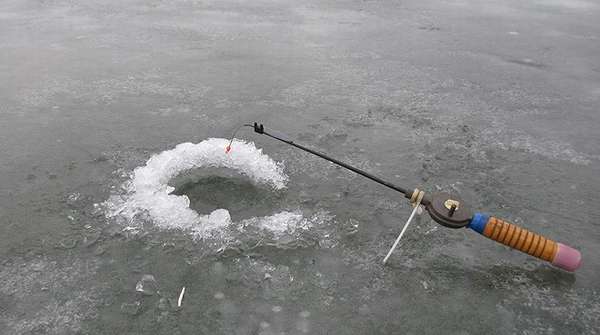
Float equipment
Winter equipment for a float rod for crucian carp:
- Winter fishing rod (balalaika, filly, any store-bought or homemade options).
- Line 0.08-0.2 mm (depending on fishing conditions and the size of the intended prey).
- Equipment of the working part.
Various options can be used as the working part:
- One jig,
- Sinker and hook,
- A heavy jig (sinker with a hook) below and a light one (hook) above on the main line (directly on it with a locomotive or on a retractable leash).
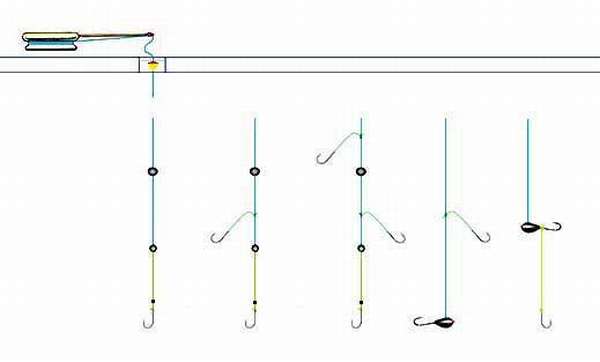
Floats on winter float rods for crucian carp should be immersed in water after loading (so as not to freeze into freezing holes). In the working position, the equipment is installed so that the lower jig lies on the bottom, and the float is 3-5 centimeters below the water line. When a crucian bites, the float usually twitches and floats up (when the fish tries the bait). Sometimes it just gets pulled down. This is standard equipment for normal biting. On a pond, you should select which jig to place (or maybe a hook), at what distance to make an additional suspension, the length of the leash, the height above the bottom, to attach one bloodworm or several, etc.
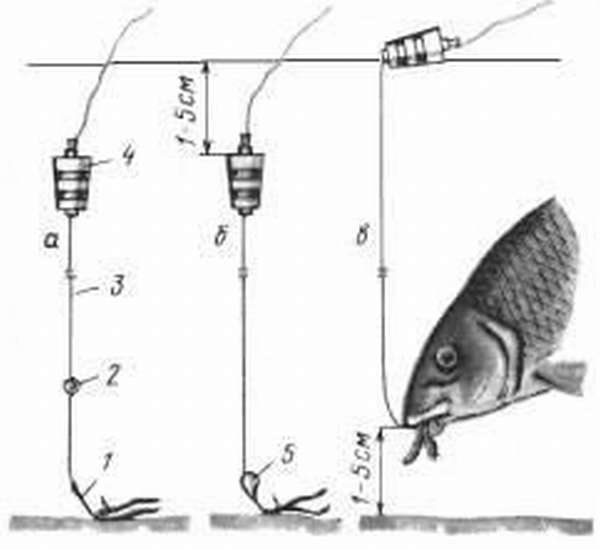
These are precisely those nuances that cannot be predicted in advance, but can only be determined on a body of water at random. Today, the silverfish can actively take large, heavy baits from the bottom, tomorrow it can carefully peck on a suspension with one bloodworm on a short leash (3 cm) 5-10 centimeters above the bottom. Therefore, at the beginning of fishing in the holes, it is advisable to set up various options for equipment in order to identify the one that works today. In any case, in deep winter it is better to use more delicate equipment. Very often, crucian carp perfectly takes micro jigs, small hooks on thin fishing line (up to 0.12 mm, which is enough in winter even for a kilogram thick fish), refusing to respond to coarser gear.
Nods
A more universal solution is to use a nodding fishing rod. Nodding gear for catching crucian carp in winter from ice expands the angler’s capabilities. You can fish with a nod both actively and passively. And catching silverfish involves a constant search for a working version of the equipment and presentation of the bait. In the middle of nowhere, nodding rigs work better. Capricious crucian carp often immediately throws the bait, feeling its weight. With the correct nod (flexible, adjusted to the weight of the equipment), when the fish lifts the bait from the bottom, part of the weight is taken by the straightening guard, without arousing suspicion. Such a bite of crucian carp is expressed in a small trembling of the nod and its rise. Sometimes you need to hook just on the rise, other times after a pause of 2-3 seconds. In the wilderness, special attention is paid to careful adjustment - passive crucian carp often throws the bait, feeling its weight. As an option, use special nods with a large operating angle. An article about nodding crossbows.
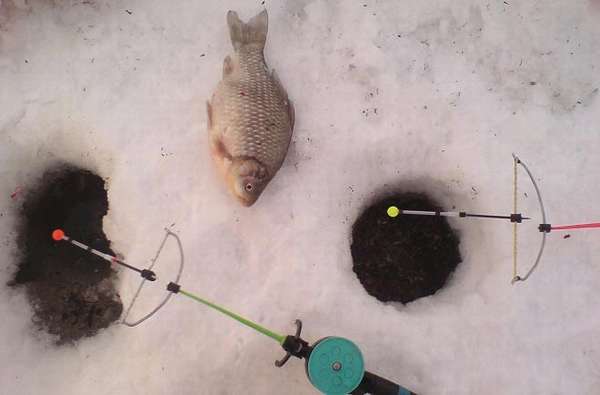
The most important thing is careful selection of the nod for the weight of the equipment. A nod that is too weak does not take the weight of the bait well, so such tackle will not work to reduce the weight of the load when lifting. On the contrary, an overly elastic nod will either not bend properly in the working position or, on the contrary, will begin to throw the jig up when the fish touches it. This will not allow you to see the weakest bites and hook in time.
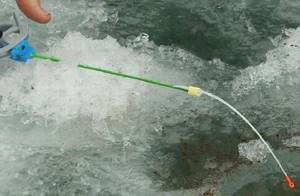
The nodding equipment of the fishing rod will allow you to use both stand-up fishing and active play at the same time. He tugged the tackle a little, tapped it on the bottom, lifted it, then put it back in place. Often bites happen just after such animations. Sometimes silver takes better not from the bottom, but above it. The nodding tackle is easily installed above the bottom, hangs freely, bending the guard. This can also be done on a fishing rod with a submersible float. But in this case, the float already signals a bite normally, since it will hang on a straight line from the tip of the fishing rod under the influence of the weight of the working part.
Equipment
To tie jigs and hooks, you can use various knots - a regular fishing knot (Canadian loop), a clinch, a palomar. A figure eight is suitable for knitting leashes. An additional hook on the main line without a leash is usually attached with a palomar knot (based on the principle of a drop shot rig).
In winter, you can catch large crucian carp using thin equipment, so, despite the delicacy, the tackle must be strong. It is better to use high-quality winter fishing lines, fluorocarbon or fluorocarbon, which are not damaged by ice and do not have memory. An additional hook almost always works, so you should equip your gear with it. It’s better to set up several tackles of different calibers in advance - this will make working on the reservoir more convenient. It can be:
- Equipment with large jigs (white, black, copper), fishing line 0.14 mm (for a stable bite).
- Delicate tackle for deep-winter fishing with micro jigs and hanging hooks with swallowtails at a height of 5-10 cm.
- Pendants with light-accumulating droplets on hooks.
Article about winter jigs for crucian carp:
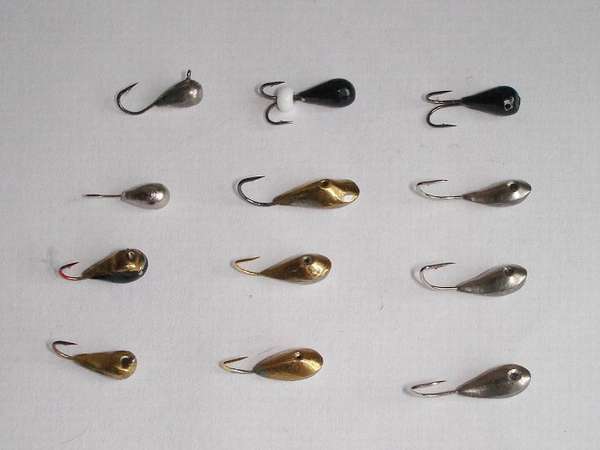
Borscht with crucian carp
Boil whole peeled beets, strain the broth and cook diced potatoes, carrots and shredded cabbage in it. Cut the beets into strips, sprinkle with vinegar and place in a cool place.
Beetroot prepared in this way gives borscht its characteristic intense dark cherry color. Finely chop the onion, fry in oil until transparent, add the tomato and simmer for 5 minutes.
Place in a decoction along with the cooked beets, add salt to taste and boil. Wash cleaned and gutted crucian carp (usual size for frying), roll in flour and fry in vegetable oil on both sides.
And here's what you need to know: What to catch fish with in Real Fishing: game review and recommendations
Put them in the borscht and boil again. Attention: do not put raw fish in the water - borscht is not fish soup - you will ruin the whole taste.
Cover with a lid and let it brew for 15–20 minutes, then serve the borscht, putting fish in each plate and seasoning with chopped herbs and sour cream to taste.
Winter donkeys for crucian carp
On reservoirs with a current, gear for catching crucian carp in winter is used with heavy equipment that can withstand the flow of water. Fishing in winter with a crucian killer, a rocker, a roller, a helicopter, or a diverting leash is advisable on rivers where the use of fishing rods with light equipment is impossible. A more powerful winter fishing rod with legs with a nod and a reel is used as a fishing rod. The design of the bottom ice tackle should be such that the fishing rod is conveniently located when installing it on the hole and is not pulled out of place by the current. The nod is selected so that the equipment in the current in the working position bends it halfway. There should be free movement of the guard to fix the bite. Options for equipping the working part of winter bottom fishing rods are shown in the photo below:
( 1 ratings, average: 5.00 out of 5)
Crucian carp stewed with onions
Peel the crucian carp (of moderate size, up to half a kilogram), gut it, rinse well and add salt. Cut the onion into rings and fry in vegetable oil, lightly salting.
https://www.youtube.com/watch?v=uKqHt-y48RM
Stuff the crucian carp with fried onions and place them in a deep frying pan. Grind flour with butter, dilute with hot cream, bring to a boil and pour this liquid over the fish.
Season to taste with salt and pepper, cover with a lid and simmer over low heat for 20-25 minutes. Crucian carp stewed with onions is served with mashed potatoes and fresh tomatoes, garnished with a bunch of parsley.
